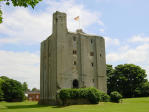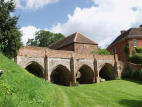


Hedingham Castle,
Essex
Pictures:
 |
This is Hedingham Castle viewed from where we had our camp set up. | |
| This is the main hall in the castle, viewed from the minstrels' gallery. We performed the majority of the musical set from near the large table at the right of this photo. |
 |
|
 |
This is the former moat with the bridge you still have to cross to enter the keep area. On the right hand side you can just see a wall. The archers shot from this wall, across the most to where the targets were set against the embankment on the opposite side. It was a good challenge. | |
References:
| Castellarium Anglicanum / | Hedingham (Hengham) TL787358 |
| D. J. Cathcart King (New York; London: Kraus International, 1983) |
"Powerful foreland position, with large and strong inner platform, bailey and counterscarp bank. Fine Norman keep standing in the middle; very tall, with two turrets rising above the battlements. Built 1130-40. Other buildings seem to have been of brick, much later and less impressive; nothing remains of them. Taken 1216, 1217. Neglected by the end of the middle ages, but much rebuilt 1485-1513; this new work demolished 1592." p. 145 |
| Essex
/ Niklaus Pevsner, revised by Enid Radcliffe (London: Penguin, 1965) [The buildings of England series] |
"It is well understandable that the castle has found its way into the name of the little town [Castle Hedingham]. It dominates the town and all the country round, it was one of the mightiest and most famous of East Anglia, it was built by, and belonged to, one of the most powerful families of Norman England, the de Veres, Earls of Oxford, and it stands to this day as an ideal picture of a keep - on a mount, high above old trees, with two of its square corner turrets still rising up to nearly 100 ft. It is besides probably the best-preserved of all tower-keeps of England. In proportion, style, and detail that of Rochester is its nearest relation, and the two may well be the work of the same architect or ingeniator, as the designer of fortifications was called..." p. 110 |
Links to pages on the castle: